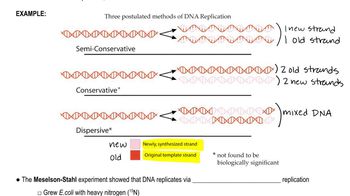Here are the essential concepts you must grasp in order to answer the question correctly.
Semiconservative Replication
Semiconservative replication is the process by which DNA is copied, resulting in two DNA molecules, each containing one original strand and one newly synthesized strand. This model was established through experiments, notably the Meselson-Stahl experiment, which demonstrated that after one round of replication, the DNA consisted of hybrid molecules, confirming that each daughter DNA retains one parental strand.
Recommended video:
Semiconservative Replication
Meselson-Stahl Experiment
The Meselson-Stahl experiment used isotopes of nitrogen to label DNA in bacteria, allowing researchers to track the distribution of parental and newly synthesized strands after replication. By analyzing the density of the DNA after centrifugation, they provided strong evidence for the semiconservative model, as the results showed a mixture of heavy and light DNA after one replication cycle.
Recommended video:
DNA Replication in Bacteria and Eukaryotes
DNA replication occurs in both bacteria and eukaryotes but involves different mechanisms and structures. In bacteria, replication starts at a single origin and proceeds bidirectionally, while eukaryotic replication involves multiple origins on each chromosome, with more complex regulation and additional proteins. Despite these differences, both processes ultimately support the semiconservative nature of DNA replication.
Recommended video:
 Verified step by step guidance
Verified step by step guidance Verified video answer for a similar problem:
Verified video answer for a similar problem:



 14:31m
14:31m